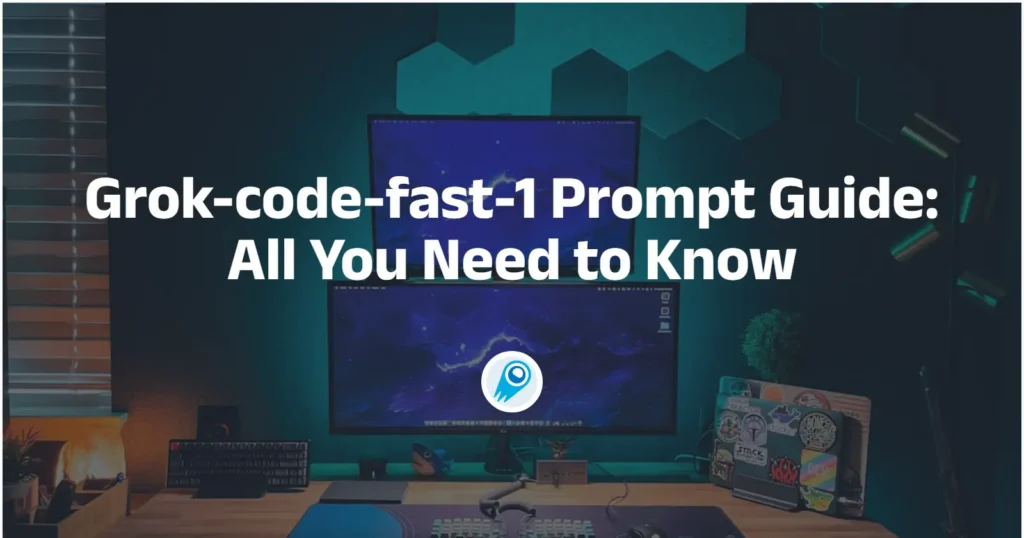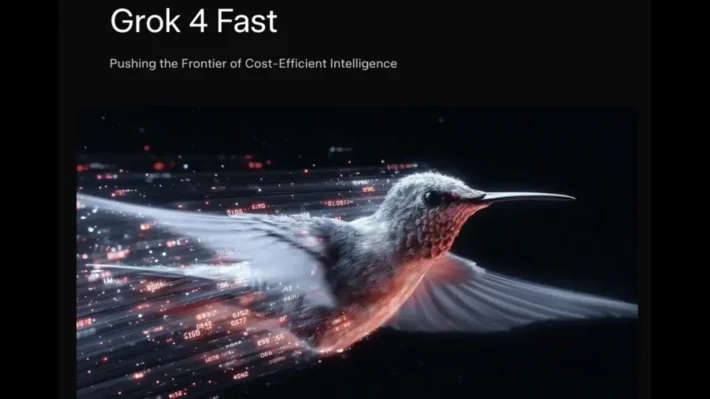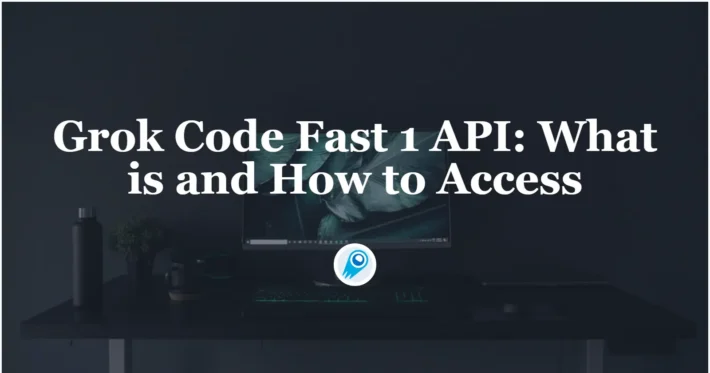Grok-code-fast-1 Prompt Guide: All You Need to Know

Grok Code Fast 1 (often written grok-code-fast-1) is xAI’s newest coding-focused large language model designed for agentic developer workflows: low-latency, low-cost reasoning and code manipulation inside IDEs, pipelines and tooling. This article offers a practical, professionally oriented prompt engineering playbook you can apply immediately.
What is grok-code-fast-1 and why should developers care?
Grok-code-fast-1 is xAI’s coding-specialized model optimized for speed, low cost, and “agentic” behaviors — i.e., planning, tool-calling, testing, and multi-step code tasks with visible reasoning traces. It’s positioned for IDE integrations and automation where responsiveness and iterative interaction matter. Practically, the model’s positioning (fast, cheap, and tuned for code) changes how you should prompt it: you can adopt an iterative, feedback-driven prompting loop rather than trying to craft a long, perfect single prompt — the model is optimized for many fast cycles.
Why it matters to engineering teams
- Latency-sensitive workflows: It’s designed to keep you “in flow” in editors and CI runs — short round-trip times for edits, refactors, and bug fixes.
- Agentic tooling: It was trained and tuned to call tools (run tests, search repos, open files) and return structured plans, which changes how you prompt and integrate the model.
- Scale and cost: The model’s pricing and token efficiency make it suitable for high-volume automated tasks (Copilot, batch codegen, test generation). Expect different prompt/temperature trade-offs when cost matters.
How should you think about prompt design for grok-code-fast-1?
What changes compared to generic LLM prompting?
grok-code-fast-1 is agentic and fast, so prompting should assume:
- The model can and will produce structured plans and call tools if asked — include explicit tool-invocation instructions.
- Short, iterative prompts are efficient. Favor stepwise microtasks over giant single-shot prompts unless you leverage the large context window.
- You can and should request visible reasoning traces for debugging outputs, but don’t expect these to be raw chain-of-thought — they’re intended to aid steering.
Practical prompt-design principles
- Be explicit about role and constraints. Start with a system/instruction that defines the model’s role (e.g., “You are a senior Python engineer. You will produce a minimal patch, tests, and a short rationale.”).
- Frame tasks as discrete steps. Structure the prompt as: Goal → Constraints → Available tools → Deliverables. This aligns with agentic behavior.
- Prefer examples / few-shots for style. Show one or two micro-examples (input → desired output). Keep examples short to reduce cost.
- Use “show plan” or “show steps” tokens for multi-step tasks. Ask the model to output a short plan before acting; then ask it to execute. This reduces hallucination in multi-file edits.
- Supply context intelligently. Use code snippets, relevant file paths, and small reproducing examples. For very large contexts, use the model’s long context abilities but prefer references (file/line) plus a few relevant extracts.
Use short setup + tool spec + example(s)
A reliable prompt pattern for agentic coding with Code Fast-1 has three parts:
- Short setup — one or two lines describing the repository context and goal.
- Tool/ability spec — what the model can call or what files you want modified; if function calling or external tools are available, enumerate them (name, inputs, outputs).
- Concrete example — one short exemplar of the desired output format (e.g., a tiny diff, or a JSON schema).
This pattern leverages the model’s speed: each micro-interaction is cheap, so providing a short scaffold and one example is enough to steer behavior without heavyweight system prompts.
Which prompt patterns and primitives work best?
“Chain-of-thought” vs. explicit reasoning traces
Grok Code Fast-1 exposes reasoning traces in its responses (visible traces of internal steps) as part of its agentic design. For production work, do not rely on long, freeform chain-of-thought for verifiability. Instead, request structured reasoning: numbered steps, a short rationale for each change, and a final, machine-readable summary (e.g., { "changes": [...], "tests": ["..."], "confidence": 0.87 }). That gives human reviewers and automated validators a clear audit trail while avoiding reliance on opaque internal monologue.
Function calling and tool contracts
If you expose function calling (or the model can call external tools like test runners, linters, or repo search), define strict contracts: function name, inputs, and expected outputs. Example:
Function: run_unit_tests
Inputs: { files: ["tests/test_db.py"] }
Outputs: { status: "pass" | "fail", failures: [{ test: string, message: string }] }
Design your prompt so that the model only uses functions you list — that prevents accidental external calls and keeps the assistant’s behavior predictable.
Error handling and “rollback” instructions
When asking the model to edit a repo, include explicit rollback instructions and a request for a patch plus undo_patch pair. This makes it straightforward for CI to test changes and automatically roll back if tests fail.
High-impact prompting patterns and micro-tricks
1. Cache Optimization
Key Point:
- Grok Code Fast-1 relies on high-speed prompt caching (90%+ hit rate).
- Avoid frequent prompt history changes that break cache and slow response.
Recommendation
✅ Keep context consistent, reuse existing conversation
❌ Avoid inserting random new prompt blocks that interrupt history
2. Provide Necessary Context
Key Point: Clearly specify which files or code sections to reference, to avoid drifting off-topic.
Bad Example:
Make error handling betterGood Example:
My error codes are defined in @error.ts, can you use that as reference
to add proper error handling and error codes to @sql.ts where I am making queries?3. Define Goals and Requirements Clearly
Key Point: State clearly what functionality, structure, and outcome you want.
Bad Example:
Create a Fitness consumption trackerGood Example
Create a Fitness consumption tracker which shows the breakdown of sports consumption per day, divided by different diveres when I enter a sports item and time. Make it such that I can see an overview as well as get high level trends.4. Advanced prompt for agentic editing (example)
System: You are an agentic code assistant with repository access. Only modify files listed in "files_to_edit". Return a JSON with fields {patches: [], tests_to_run: [], explanation: "", confidence: 0.0-1.0}. Do not request additional tools.
User:
Context: monorepo, service users-service in services/users, failing test services/users/tests/test_create_user.py
Task: Find minimal edit(s) to fix the failing test. Prefer small, easily reviewable diffs. Add one unit test if necessary.
Files_to_edit: ["services/users/src/users.py", "services/users/tests/test_create_user.py"]
Output schema example: { "patches":[{"path":"services/users/src/users.py","diff":"---..."}], "tests_to_run":["services/users/tests/test_create_user.py"], "explanation":"3 concise steps", "confidence":0.92 }This prompt makes the output machine-readable, constrains the model’s editing scope, and requests a confidence score — all of which help automation and review.
What are practical prompt templates you can use today?
Below are practical templates (system + user) you can paste into an API call or Copilot prompt. Replace placeholders (<...>) with real content.
Template A — Quick bug fix (single-file)
SYSTEM: You are "grok-code-fast-1", an expert engineer. Prioritize minimal, correct changes and include a one-line rationale.
USER:
Goal: Fix the failing test `test_parse_dates` in file `utils/date_parser.py`.
Context:
- repo root: /project
- failing test stacktrace: KeyError at date_parser.py:42
- show only the minimal patch (unified diff), a one-line rationale, and one unit test that reproduces the fix.
Constraints:
- Keep behavior backward-compatible for existing valid date strings.
- No external dependencies.
Deliverable format:
1) PATCH (unified diff)
2) RATIONALE (one line)
3) TEST (pytest function)
Why this works: requests a minimal patch, gives constraints, and demands a small test — aligns with agentic workflows (plan → act → verify).
Template B — Multi-file refactor with plan
SYSTEM: You are an experienced refactorer. Provide a short plan, then apply the plan with diffs for each file changed.
USER:
Goal: Extract common validation logic from `auth/login.py` and `auth/register.py` into `auth/_validators.py`.
Step 0: Produce a 3–5 step plan.
Step 1: Show the plan only.
Step 2: After I confirm (or you can proceed), produce unified diffs for changed files and update import paths.
Deliverable format:
- PLAN: numbered steps
- DIFFS: unified diffs for each file changed
- TESTS: a minimal test if needed
Why this works: two-stage prompts reduce accidental overreach and let you validate the plan before code changes.
Template C — Generate tests and CI check
SYSTEM: You are a QA engineer. Output runnable pytest test cases with fixtures and a shell snippet for adding a CI job that runs tests and lint.
USER:
Goal: For module `payment/processor.py`, generate unit tests that cover:
- successful charge
- network timeout (mocked)
- idempotency behavior
Deliverable:
1) pytest tests (file path)
2) sample GitHub Actions job (YAML) that runs tests and reports coverage
What are recommended prompt patterns and prompts you should avoid?
Recommended patterns
- Plan-first, execute-second: Ask for a short plan before asking for code changes. It reduces errors.
- Constrain outputs to machine-friendly formats: JSON, unified diffs, or
---SECTION---blocks are easier to parse programmatically. - Ask for tests and safety checks: When generating code, include a request for unit tests and edge-case checks.
- Use “tool affordances” explicitly: If your integration supports tools (file read/write, test runner), instruct: “If you need to run tests, call
run_tests()tool.” This leverages the model’s agentic capabilities.
Prompts to avoid
- Huge monolithic instructions expecting a full system design in one shot without planning — prefer iterative decomposition.
- Vague role-less prompts like “write this function” without constraints — they increase hallucination risk.
- Requests for unrestricted internet browsing or content that may be sensitive without guardrails — prefer explicit tool boundaries and logging.
When to ask for “reasoning traces” vs. concise answers
grok-code-fast-1 can emit visible reasoning traces. Use them when you need auditability (code review, security checks). But when you want compact code only (to paste into CI), request “no reasoning—only patch” in the constraints. Example: If you include reasoning traces, put them in a REASONING block and limit to 6 bullet points. This keeps outputs parsable while preserving transparency when needed.
How do you integrate grok-code-fast-1 into tool chains (IDE, CI, bots)?
IDE (Copilot / VS Code) patterns
- Inline micro-prompts: Ask the model to propose a single-line change with rationale as a code action.
- Refactor assistant: Use plan-first prompts when performing cross-file edits; show proposed diffs in a preview.
- Unit-test generator: Trigger test-generation for newly added functions with a short prompt: “Generate pytest tests for the newly changed function.”
Note: Grok Code Fast 1 is rolling out as a preview in GitHub Copilot and supports BYOK for enterprise keys. Test in a sandbox before wholesale adoption.
CI / Automation
Cost control: Use short prompts and programmatic templates in batch jobs to limit token usage; take advantage of the model’s cost-efficiency but monitor billing.
Automated PR agent: Make the agent produce a plan + patch + tests + CI job. Always gate with human review and automated lint/test steps.
Recommended pattern:
- Run the model in a sandbox (container) with read-only access to a narrow set of files.
- Require proposed patches to pass unit tests in a gated environment.
- Log reasoning traces to an audit trail for later review.
Conclusion: how to start today
grok-code-fast-1 presents a practical, high-speed option for embedding agentic coding workflows into IDEs and CI. Start small: onboard a noncritical repository, apply the templates above, and run a two-week A/B evaluation against your existing developer workflows. Measure accuracy, cost, and human acceptability before broader rollout.
Getting Started
CometAPI is a unified API platform that aggregates over 500 AI models from leading providers—such as OpenAI’s GPT series, Google’s Gemini, Anthropic’s Claude, Midjourney, Suno, and more—into a single, developer-friendly interface. By offering consistent authentication, request formatting, and response handling, CometAPI dramatically simplifies the integration of AI capabilities into your applications. Whether you’re building chatbots, image generators, music composers, or data‐driven analytics pipelines, CometAPI lets you iterate faster, control costs, and remain vendor-agnostic—all while tapping into the latest breakthroughs across the AI ecosystem.
Developers can access Grok-code-fast-1 API ( model: grok-code-fast-1) through CometAPI, the latest model version is always updated with the official website. To begin, explore the model’s capabilities in the Playground and consult the API guide for detailed instructions. Before accessing, please make sure you have logged in to CometAPI and obtained the API key. CometAPI offer a price far lower than the official price to help you integrate.
Ready to Go?→ Sign up for CometAPI today !
FAQs about grok-code-fast-1
1. When Code Fast-1 is the right fit
High-volume, short operations: code completion, small edits, tests, and quick refactors where speed and cost matter.
- Agentic pipelines: where the model orchestrates small tooling calls (run tests, edit files, re-run) in a loop.
- IDE augmentations: in-editor pair-programmer experiences where low latency is critical.
2. How do cost, context size, and token strategy affect prompt design?
- Context window: grok-code-fast-1 supports very large contexts in some providers (open-router metadata indicates large windows for repo-scale reasoning). For large codebases, prefer file references with small extracts instead of embedding entire repos.
- Token pricing & strategies: If pricing is usage-sensitive, prefer:
- shorter prompts and incremental interactions,
- programmatic post-processing (diff-only) instead of full-file dumps,
- caching of common prompts and outputs.
3. Can you see the model’s reasoning traces — and how should prompts request them?
grok-code-fast-1 surfaces visible reasoning traces to help steer agentic actions (e.g., “Plan: 1) open file X, 2) run tests, 3) edit function”). Use prompts like:
"Please provide a short PLAN (3 items max) before producing diffs. Show your internal reasoning steps as a numbered plan, then produce code."Guidance: Use plan traces for diagnosis and to implement guard rails. Don’t treat fine-grained internal text as private chain-of-thought in high-stakes decisions.



